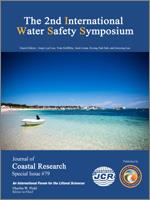Suh, S.-W.; Kim M.-J., and Kim, H.-J., 2017. Prediction of sand beach variations by coupling of hydrodynamic and morphological models during extreme storms. In: Lee, J.L.; Griffiths, T.; Lotan, A.; Suh, K.-S., and Lee, J. (eds.), The 2nd International Water Safety Symposium. Journal of Coastal Research, Special Issue No. 79, pp. 284–288. Coconut Creek (Florida), ISSN 0749-0208.
Beaches are constantly affected by hydrodynamic forcing. Among various factors, a wave impact is the major reason for beach formation and erosion. In order to provide efficient coupling for the morphological variations in beaches, we consider an unstructured ADCIRC SWAN model and an orthogonal curvilinear XBeach model. When coupling these heterogeneous models, external Perl scripts are implemented to automatically convey simulated extreme wave and tide conditions for the XBeach input. The application of the model to the hindcasting of typhoons Maemi and Neoguri at Haeundae Beach in Korea shows satisfactory beach variations. Moreover, through sensitivity tests, we find that a wave height of 2 m behaves as a threshold value in the beach environment. Since the coupled model can be easily extended for real-time simulation, it can be employed in an early-warning system to provide beach safety.





